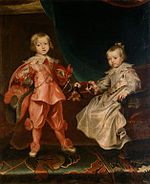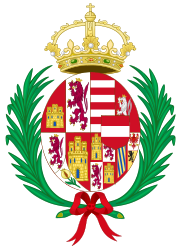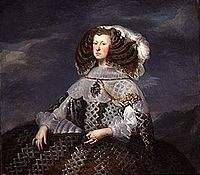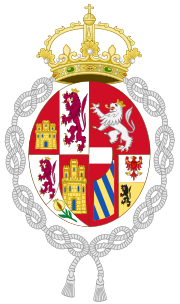- Mariana of Austria
-
Mariana of Austria 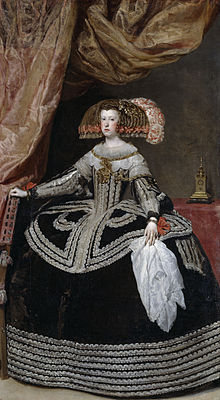
Mariana in 1652 by Velázquez, Prado Museum, Madrid. Queen consort of Spain Tenure 7 October 1649 – 17 September 1665 Spouse Philip IV of Spain Issue Margaret Theresa, Holy Roman Empress
Philip Prospero, Prince of Asturias
Charles II of SpainFull name Maria Anna House House of Habsburg Father Ferdinand III, Holy Roman Emperor Mother Maria Ana of Austria Born 24 December 1634
Wiener Neustadt, AustriaDied 16 May 1696 (aged 61)
Uceda Palace, Madrid, SpainBurial El Escorial Religion Roman Catholicism Mariana of Austria (Maria Anna; 24 December 1634 – 16 May 1696) was Queen consort of Spain as the second wife of King Philip IV, who was also her maternal uncle. At the death of her husband in 1665, Mariana became Queen regent, and she remained an influential figure during the reign of her son Charles II, the last Spanish Habsburg.
Contents
Early life
Born as Maria Anna on 22 December 1634 in Wiener Neustadt, Austria, she was the granddaughter of Holy Roman Emperor Ferdinand II. Her parents were King Ferdinand III of Hungary and Maria Anna of Spain, the sister of Mariana's future husband, King Philip IV of Spain. Her father, who would become Emperor in 1637, was as yet only King of Hungary and Bohemia, and was away for most of his wife's pregnancy campaigning in the Thirty Years' War.
Maria Anna, was the second of six children, three of which died in early childhood. Her oldest brother, Ferdinand IV of Hungary died young. Only Maria Anna and her younger brother, the future Holy Roman Emperor Leopold I, lived to reach old age.
Marriage
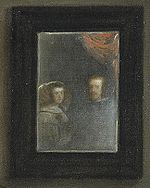 The reflection of Mariana and Philip IV appears in Las Meninas, by Velázquez.
The reflection of Mariana and Philip IV appears in Las Meninas, by Velázquez.
Maria Anna was destined from her early years to continue the marriage policy between the two branches of the Habsburg family, the Austrian and the Spanish. A policy of inbreeding followed for generations. Following this policy, in 1646 Maria Anna, then eleven years old, was engaged to her Spanish Habsburg first cousin Balthasar Charles, Prince of Asturias, heir of the Spanish crown. However, he died only three months later age 16. With Baltasar Carlos's death, Philip IV was left without a male heir and Maria Anna without a fiancé. Philip was widower, as his beautiful and beloved French wife, Elisabeth of France, had just died a few years prior. Philip decided to marry his 14 year old niece himself. After a marriage by proxy, they were wedded on 7 October 1649 in Navalcarnero, near Madrid, and spent their wedding night at El Escorial. From then on, she went by her name in Spanish, Mariana. Although known for being cheerful as a young girl, after her wedding to her uncle she became cold and bad-tempered.
Mariana and Philip's marriage produced five children, however, only two lived into adulthood. Their first child was Margaret Theresa, who was born on 12 July 1651; just as her mother did, she went on to marry her maternal uncle Leopold I, Holy Roman Emperor. In 1655, Mariana then had another daughter, Maria Ambrosia de la Concepción; she only lived fifteen days. During this time, there were those at court who wanted Philip to officially name his eldest daughter, Maria Theresa, as his heir, as she was already heir presumptive according to Spanish tradition. Mariana began feeling the pressure to have a son. Eventually, her first son, Philip Prospero, was born on 28 November 1657, who was joyously received. She then gave birth to the Infante Ferdinand Thomas in 1658, but he died a year later in 1659.
Sadly, her son Philip Prospero died in 1661. But that same year, Mariana gave birth to her last child, a son; he was named Charles and was born on 6 November.
Charles was born physically and mentally disabled, and disfigured. Possibly through affliction with mandibular prognathism, he was unable to chew. His tongue was so large that his speech could barely be understood, and he frequently drooled. It has been suggested that he suffered from the endocrine disease acromegaly,[1] or his inbred lineage may have led to a combination of rare genetic disorders such as combined pituitary hormone deficiency and distal renal tubular acidosis.[2]
Consequently, Charles II is known in Spanish history as El Hechizado ("The Hexed") from the popular belief – to which Charles himself subscribed – that his physical and mental disabilities were caused by "sorcery." The king went so far as to be exorcised.
Mariana by Velázquez
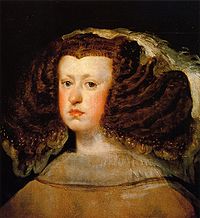 Mariana by Velázquez, c. 1656.
Mariana by Velázquez, c. 1656.
Spain's most famous painter at the time, Diego Velázquez, stayed in Rome from 1649 to 1650. Philip IV wanted his favourite court painter, now enjoying such a triumph in Rome, to paint his second wife, Mariana, and to give his advice on the renovation of the old royal palace in Madrid, the Alcázar. Consequently, he wished Velázquez to come back to court as soon as possible, but nonetheless the artist delayed his return for another whole year.
The official portrait of Mariana, commissioned by the king, is the most famous one of her, and today it hangs in the Prado Museum, in Madrid. The painting was copied, and one of the copies hangs in the Kunsthistorisches Museum in Vienna. The original portrait was not completed until 1652. Mariana was just nineteen at the time that it was painted. It shows her full length, wearing a black dress with silver braid, and of course adorned with much valuable jewellery: gold necklaces and bracelets, and a large gold brooch on her close-fitting bodice. Her right hand rests on the back of a chair, and she holds a delicate lace scarf in her left hand. The picture is bathed in harmonious shades of black and red, although the dramatically drawn curtain has been painted over by another hand.
The composition turns on the focal point of the queen's alabaster skin and rouged face, small and almost doll-like under her hair, which is dressed very wide. Her bust, tightly encased in the bodice, her stiff farthingale and all her fashionable magnificence are rendered true to life by Velázquez, and at the same time he reveals them as a theatrical show concealing the girl's natural physical nature beneath the armour of courtly constraint.
Regency
When Philip IV died on 17 September 1665, their only surviving son, Charles, was only 3 years old, and Mariana served as regent, relying on her confessor, Juan Everardo Nithard, for support until his dismissal in 1669. Charles, at most times unable to walk or speak, needed a regent more than most child kings, and was carried as an infant in an adult's arms until he was 10. In 1668, a voyage led by Jesuit missionary San Vitores named the Mariana Islands in the North Pacific after the queen regent. Also that year, Spain entered the War of Devolution; it lost most of its land in the Spanish Netherlands to France. Mariana served as his regent for much of his life. She suffered greatly[citation needed] upon receiving the news of the death of her daughter, the Holy Roman Empress, Margaret Theresa, in Vienna in 1673. In 1675, her son Charles reached the age he need to be to rule, however, Mariana continued to rule most of the time due to her son's illnesses. In 1677, Mariana was driven from Madrid by John of Austria the Younger, an illegitimate son of Philip IV. The palace coup was due to widespread dissatisfaction at court with her support for her new advisor Fernando de Valenzuela.[citation needed] She went to live in Toledo, but returned to Madrid upon John's death in 1679.
Later life
That same year, her son Charles II married the French princess Marie Louise d'Orléans. Although he was madly in love with her, their marriage remained childless. Ten years later, in 1689, Marie Louise died under mysterious circumstances. At the time, there were rumours saying that she had been poisoned by the notorious intrigante Olympia Mancini, Countess of Soissons, at the behest of Mariana, the dowager queen, because Marie Louise had not given birth to any children. This is questionable since Mariana and Marie Louise were close and the dowager queen was also devastated at the young Marie Louise's death. It seems likely that the real cause of her death was appendicitis.[citation needed]
Charles married again, this time a German princess: Maria Anna of Neuburg. However, this second marriage was also childless. His new wife was in very bad terms with the Queen Mother, Mariana, who wanted her great-grandson, Joseph Ferdinand of Bavaria, to become the next King of Spain. This led to frequent arguments with her second-daughter-in-law, Maria Anna of Neuburg, who wanted her nephew, Archduke Charles of Austria, to become the next King of Spain. After many unpleasant arguments, the Queen Mother stated: "Two suns cannot live in the same sky".[citation needed] Once during an argument between the two royal ladies, the Queen Mother told her: "Learn to live, lady, and know once and for all that people far higher than you have humbled themselves before me, people over whom you have only one advantage, that you are the wife of my son, an honour which you owe to me alone." The hysterical Maria Anna replied: "That is why I hate you so much!"[citation needed]
As her great-grandson, Joseph Ferdinand, died childless, Mariana has no descendants today.
Death
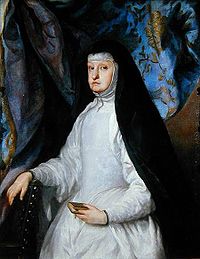 Mariana, as a widow, in her later years, by Claudio Coello, c. 1685–1693
Mariana, as a widow, in her later years, by Claudio Coello, c. 1685–1693
Mariana died of breast cancer on the night of 16 May 1696 at the Uceda Palace in Madrid, Spain, at the moment when a total eclipse of the moon reached its maximum and the Spanish capital was completely covered in darkness. Soon after her funeral, some miracles begun to be reported. When her coffin was taken out so the crowds could say farewell, a white dove was seen flying around it and finally disappeared into the heavens. Everyone thought it was an omen. A nun who had attended the Queen Mother at the palace begged a garment for remembrance; she slept in it and next morning awoke cured of a life-long paralysis. The British ambassador in Madrid, Lord Alexander Stanhope, wrote about this subject:
There is now great noise of a miracle, done by a piece of waistcoat she died in, on an old lame nun, who in great faith earnestly desired it, and so sooner applied it to her lips, but she was perfectly well, and immediately threw away her crutches. This, with some other stories, which will not be wanting, may in time grow up to a canonization.The infamous Countess of Berlips, a German lady living at the Spanish court, wrote the following lines on the subject:
The miracles attributed to her after her death are not yet proved. One knows how easily such things are made up and attributed to people who have been calumniated while alive. There is no doubt that the dead Queen was a saint, because of her irreproachable conduct all her life, but the Spaniards don't deserve miracles from her, since they embittered her existence.Issue
- Margaret Theresa (1651–1673) married Leopold I, Holy Roman Emperor.
- Maria Ambrosia (1655)
- Philip Prospero, Prince of Asturias (1657–1661).
- Ferdinand Thomas (1658–1659)
- Charles II of Spain (1661–1700) married Marie Louise of Orléans and Maria Anna of Neuburg.
Ancestors
Bibliography
- Calvo Poyato, José, La vida y epoca de Carlos II el Hechizado (Barcelona: Editorial Planeta, 1998).
- Calvo Poyato, José, Reinas viudas de España (Barcelona: Península, 2002).
- Fisas, Carlos, Historias de las reinas de España: la Casa de Austria (Barcelona: Editorial Planeta, 1999).
- González-Doria, Fernando, Las reinas de España (Madrid: Trigo, 2003).
- Maura Gamazo, Gabriel, Vida y reinado de Carlos II (Madrid: Espasa Calve, 1942).
- Pfandl, Ludwig, Carlos II (Madrid: Afrodisio Ago, 1947).
References
- ^ http://www.xs4all.nl/~monarchs/madmonarchs/carlos2/carlos2_bio.htm
- ^ Gonzalo Alvarez, Francisco C. Ceballos, Celsa Quinteiro (April 15, 2009). "The Role of Inbreeding in the Extinction of a European Royal Dynasty". PLoS ONE. http://www.plosone.org/article/info%3Adoi%2F10.1371%2Fjournal.pone.0005174. Retrieved 2009-04-16.
External links
- http://www.xs4all.nl/~kvenjb/madmonarchs/carlos2/carlos2_bio.htm A biography of Charles II of Spain in Joan's Mad Monarchs Series
Titles
Mariana of AustriaBorn: 23 December 1634 Died: 16 May 1696Spanish royalty Vacant Title last held byElisabeth of FranceQueen consort of Spain
7 October 1649 – 17 September 1665Vacant Title next held byMarie Louise of OrléansSpanish royal consorts Princess Sophía of Greece and Denmark (1975–)
Princess Victoria Eugenie of Battenberg (1906–1931) · Archduchess Maria Christina of Austria (1879–1885) · Princess Mercedes of Orléans (1878) · Maria Vittoria dal Pozzo (1870–1873) · Infante Francis of Spain, Duke of Cádiz (1846–1868) · Princess Maria Christina of the Two Sicilies (1829–1833) · Princess Maria Josepha of Saxony (1819–1829) · Infanta Maria Isabel of Portugal (1816–1818) · Julie Clary (1808–1813) · Princess Maria Luisa of Parma (1788–1808) · Princess Maria Amalia of Saxony (1759–1760) · Infanta Barbara of Portugal (1746–1758) · Elisabeth Farnese (1724–1746) · Louise Élisabeth d'Orléans (1724) · Elisabeth Farnese (1714–1724) · Princess Maria Luisa of Savoy (1701–1714) · Countess Palatine Mariana of Neuburg (1690–1700) · Marie Louise d'Orléans (1679–1689) · Archduchess Mariana of Austria (1649–1665) · Princess Élisabeth of France (1621–1644) · Archduchess Margaret of Austria (1598–1611) · Archduchess Anna of Austria (1570–1580) · Princess Élisabeth of France (1559–1568) · Queen Mary I of England (1556–1558) · Infanta Isabella of Portugal (1526–1539)Austrian archduchesses by birth 1st generation none2nd generation Archduchess Helena · Kunigunde, Duchess of Bavaria3rd generation 4th generation Eleanor, Queen of France* · Isabella, Queen of Denmark and Norway* · Maria, Queen of Hungary* · Catherine, Queen of Portugal*5th generation Elisabeth, Queen of Poland · Maria, Holy Roman Empress* · Anna, Duchess of Bavaria · Archduchess Isabella* · Maria, Duchess of Jülich-Cleves-Berg · Archduchess Magdalena · Catherine, Queen of Poland · Eleanor, Duchess of Mantua · Archduchess Margaret · Joan, Princess of Portugal* · Barbara, Duchess of Ferrara · Archduchess Ursula · Archduchess Helena · Joanna, Grand Duchess of Tuscany6th generation Anna, Queen of Spain · Elisabeth, Queen of France · Archduchess Maria · Archduchess Maria · Isabella Clara Eugenia, Co-sovereign of the Habsburg Hetherlands* · Archduchess Margaret · Catherine Michelle, Duchess of Savoy* · Archduchess Eleanor · Archduchess Maria* · Archduchess Martha · Archduchess Anna Eleanor · Archduchess Maria · Anna, Holy Roman Empress · Anna, Queen of Poland · Maria Christina, Princess of Transilvania · Archduchess Catherine Renata · Archduchess Elisabeth · Archduchess Gregoria Maximiliana · Archduchess Eleanor · Margaret, Queen of Spain · Constance, Queen of Poland · Maria Maddalena, Grand Duchess of Tuscany7th generation Archduchess Christine · Anna, Queen of France* · Archduchess Maria · Maria Anna, Holy Roman Empress* · Archduchess Anna Mauritia · Maria Anna, Electress of Bavaria · Archduchess Margarita Francisca* · Cecilia Renata, Queen of Poland · Archduchess Maria Eleanor · Isabella Clara, Duchess of Mantua · Maria Leopoldine, Holy Roman Empress8th generation Archduchess Maria Margarita* · Archduchess Margarita Maria Catalina* · Archduchess Maria Eugenia* · Archduchess Isabella Maria Teresa* · Maria Anna, Queen of Spain · Archduchess Maria Anna Antonia* · Maria Theresa, Queen of France* · Archduchess Maria · Margarita Teresa, Holy Roman Empress* · Archduchess Theresia Maria Josepha · Eleanor, Queen of Poland, Duchess of Lorraine · Claudia Felicitas, Holy Roman Empress · Maria Anna Josepha, Electoral Princess of the Palatinate · Archduchess Maria Ambrosia de la Concepción* · Archduchess Maria Magdalena9th generation Maria Antonia, Electress of Bavaria · Archduchess Maria Anna Antonia · Archduchess Anna Maria · Archduchess Maria Josepha · Archduchess Christina · Archduchess Maria Elisabeth · Maria Anna, Queen of Portugal · Archduchess Maria Theresa · Archduchess Maria Josepha · Archduchess Maria Magdalena · Archduchess Maria Margaretha10th generation Maria Josepha, Queen of Poland · Maria Amalia, Holy Roman Empress · Maria Theresa · Maria Anna, Princess Charles Alexander of Lorraine · Archduchess Maria Amalia11th generation Archduchess Maria Elisabeth** · Archduchess Maria Anna** · Archduchess Maria Carolina** · Maria Christina, Duchess of Teschen** · Archduchess Maria Elisabeth** · Maria Amalia, Duchess of Parma** · Archduchess Maria Carolina** · Archduchess Johanna** · Archduchess Maria Josepha** · Maria Carolina, Queen of Naples** · Marie Antonia, Queen of France**12th generation Archduchess Maria Theresa · Archduchess Marie Christine · Maria Theresia, Queen of Saxony** · Archduchess Maria Anna** · Maria Theresa, Queen of Sardinia*** · Archduchess Maria Josepha*** · Maria Leopoldine, Electress of Bavaria*** · Maria Clementina, Duchess of Calabria** · Archduchess Maria Amalia** · Archduchess Maria Antonia*** · Maria Ludovika, Empress of Austria***13th generation Archduchess Ludovika Elisabeth · Marie Louise, Empress of the French · Archduchess Carolina Ferdinande** · Archduchess Maria Caroline · Archduchess Caroline Ludovika · Maria Leopoldina, Empress of Brazil · Clementina, Princess of Salerno · Archduchess Maria Luisa** · Archduchess Alexandrine · Maria Theresa, Queen of Sardinia** · Marie Caroline, Crown Princess of Saxony · Archduchess Maria Anna · Archduchess Amalia Theresa · Maria Theresa, Queen of the Two Sicilies · Maria Theresa, Countess of Chambord*** · Archduchess Hermine · Archduchess Franziska · Archduchess Maria Caroline · Adelaide, Queen of Sardinia · Maria Beatrix, Countess of Montizón*** · Archduchess Maria Caroline · Archduchess Elisabeth Franziska · Marie Henriette, Queen of the Belgians14th generation Archduchess Maria Anna · Archduchess Maria Carolina** · Auguste Ferdinande, Princess Luitpold of Bavaria** · Archduchess Maria Maximiliana** · Maria Isabella, Countess of Trapani** · Archduchess Maria Theresia** · Archduchess Maria Cristina** · Archduchess Maria Anna** · Maria Theresa, Duchess Philipp of Württemberg · Archduchess Mathilda · Maria Christina, Queen of Spain · Archduchess Maria Eleonora · Archduchess Elisabeth · Maria Dorothea, Duchess of Orléans · Margaretha Klementine, Princess of Thurn and Taxis · Archduchess Elisabeth Henriette · Archduchess Klotilde · Maria Theresa, Queen of Bavaria***15th generation Archduchess Sophie · Gisela, Princess Leopold of Bavaria · Archduchess Marie Valerie · Margarete Sophie, Duchess of Württemberg · Archduchess Maria Annunziata · Elisabeth, Princess Aloys of Liechtenstein · Archduchess Maria Antonietta** · Luise, Crown Princess of Saxony** · Anna, Princess of Hohenlohe-Bartenstein** · Archduchess Margareta** · Archduchess Germana** · Archduchess Agnes** · Archduchess Maria Theresa** · Karoline Marie, Princess Leopold of Saxe-Coburg and Gotha** · Archduchess Maria Antonietta** · Maria Immaculata, Duchess of Württemberg** · Archduchess Henriette** · Maria Christina, Princess Emmanuel of Salm-Salm · Maria Anna, Princess Elias of Bourbon Parma · Maria Henrietta, Princess of Hohenlohe-Waldenburg-Schillingsfürst · Archduchess Natalie · Archduchess Stephanie · Archduchess Gabrielle · Isabella, Princess Georg of Bavaria · Alice, Baroness Waldbott of Bassenheim · Archduchess Eleonora, Mrs. Alfons von Kloss · Renata, Princess Hieronymus Radziwill · Mechthildis, Princess Olgierd Czartoryski · Archduchess Gisele · Archduchess Sophie · Archduchess Magdalena16th generation Elisabeth Marie, Princess of Windisch-Graetz · Helena, Duchess Philipp of Württemberg** · Rosa, Duchess of Württemberg** · Archduchess Dolores** · Maria Inmaculada, Nobile Inigo Neri Sereneri** · Margarita, Marchioness Taliani di Marchio** · Princess Maria Antonia, Mrs. Luis Pérez** · Archduchess Assunta, Mrs. Joseph Hopfinger** · Elisabeth, Countess of Waldburg-Zeil** · Hedwig, Countess of Stolberg-Stolberg** · Gertrud, Countess of Waldburg-Zeil-Trauchburg** · Archduchess Maria Elisabeth** · Archduchess Agnes** · Archduchess Margarethe, Mrs. Alexander Cech · Ilona, Duchess of Mecklenburg · Archduchess Anna Theresia · Archduchess Maria Kynga, Mrs. Joachim Krist17th generation Archduchess Adelheid · Charlotte, Duchess of Mecklenburg · Elisabeth, Princess Heinrich of Liechtenstein · Elisabeth, Edle Hubert von Braun** · Alice, Baroness Vittorio Manno** · Marie Antoinette, Baroness of Proff in Irnich** · Archduchess Marie Christine** · Archduchess Walburga, Mrs. Carlos Tasso** · Archduchess Verena** · Archduchess Katharina, Mrs. Roland Huber** · Agnes, Baroness Peter of Fürstenberg** · Maria Ileana, Countess Adam Kottulinski** · Alexandra, Baroness Viktor of Baillou** · Maria Magdalena, Baroness of Holzhausen** · Archduchess Elisabeth, Mrs. Friedrich Sandhofer** · Agnes, Princess Karl Alfred of Liechtenstein** · Archduchess Maria Margaretha** · Archduchess Ludovica** · Archduchess Allix** · Josepha, Countess Clemens of Waldstein-Wartenberg** · Valerie, Margravine of Baden** · Alberta, Baroness Alexander of Kottwitz-Erdödy** · Theresa, Princess Rasso of Bavaria** · Maria Inmakulata, Countess Reinhart of Hoensbroech** · Archduchess Monika, Mrs. Charles de Rambures · Archduchess Marie Christine, Mrs. Raymond van der Meide · Archduchess Maria, Mrs. Wilhelm de Witt · Margherita, Countess Benedikt of Piatti18th generation Andrea, Hereditary Countess of Neipperg · Monika, Duchess of Maqueda · Michaela, Countess Hubertus of Kageneck · Archduchess Gabriela, Mrs. Christian Meister · Walburga, Countess Archibald Douglas · Maria Beatrix, Countess Riprand of Arco-Zinneberg*** · Isabella, Countess Andrea Czarnocki-Lucheschi*** · Maria del Pilar, Edle Vollrad-Joachim von Poschinger · Kinga, Baroness Wolfgang of Erffa · Archduchess Marie Adelheid, Mrs. Jaime Corcuerra · Archduchess Viridis, Mrs. Karl Dunning-Gribble · Archduchess Alexandra, Mrs. Héctor Riesle · Maria Constanza, Princess of Auersperg-Trautson · Maria Anna, Princess Peter Galitzine · Catharina, Countess Maximiliano Secco d'Aragona · Archduchess Elisabeth, Mrs. James Litchfield · Sophie, Princess of Windisch-Grätz · Archduchess Marie Christine, Mrs. Clemens Guggenberg · Archduchess Marie Bernadette, Mrs. Rupert Wolff** · Archduchess Katharina, Mrs. Niall Brooks** · Archduchess Alicia** · Archduchess Maria Christina** · Archduchess Margaretha, Mrs. Andreas Baumgartner** · Archduchess Marie Valerie, Mrs. Martin Josef Wagner** · Archduchess Hedwig** · Archduchess Veronika** · Archduchess Johanna · Archduchess Elisabeth · Archduchess Celina · Archduchess Maria Floriana · Archduchess Sofía · Archduchess Anna Carolina · Archduchess Theresa · Archduchess Sophie · Archduchess Ladislaya19th generation Archduchess Eleonore · Archduchess Gloria · Archduchess Sophie · Archduchess Hilda · Archduchess Maria Laura*** · Archduchess Luisa Maria*** · Archduchess Laetitia Maria*** · Archduchess Sophia · Archduchess Maria Theresa · Archduchess Margherite · Archduchess Priscilla · Archduchess Marie des Neiges · Marie Christine, Countess Rodolphe of Limburg-Stirum · Archduchess Gabriella · Archduchess Antonia · Archduchess Isabelle · Archduchess Carlotta · Archduchess Paulina · Archduchess Lara · Archduchess Katharina · Archduchess Tatyana** · Archduchess Anabella** · Archduchess Tara** · Archduchess Amaya20th generation Archduchess Zita · Archduchess Anežka*also an infanta of Spain
**also a princess of Tuscany
***also a princess of ModenaCategories:- 17th-century Austrian people
- House of Habsburg
- Spanish royal consorts
- Female regents
- Royal consorts of Naples
- Royal consorts of Sicily
- Duchesses of Burgundy
- Duchesses of Brabant
- Duchesses of Limburg
- Duchesses of Luxembourg
- Countesses of Burgundy
- Countesses of Flanders
- Countesses of Hainaut
- Countesses of Artois
- Queen mothers
- Regents of Spain
- Archduchesses of Austria
- Bohemian princesses
- Hungarian princesses
- Duchesses of Milan
- Austrian expatriates in Italy
- Austrian expatriates in Spain
- Spanish people of Austrian descent
- People from Vienna
- People from Wiener Neustadt
- Deaths from breast cancer
- Cancer deaths in Spain
- 1634 births
- 1696 deaths
- Burials in the Pantheon of Kings at El Escorial
Wikimedia Foundation. 2010.

